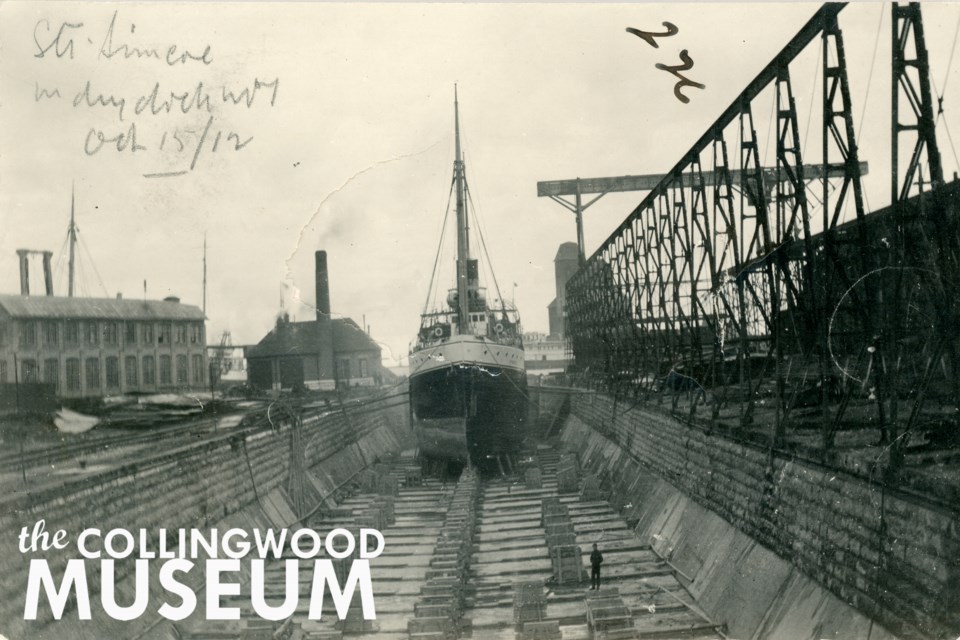Today’s featured photograph showcases Collingwood’s original dry dock in operation in 1912. Its distinctive stone cribbing is nicely visible along the dock’s east and west walls.
A dry dock is a narrow basin that can be flooded to allow a ship (or load) to be floated in, then drained to allow that ship to come to rest on a dry platform where crews can perform construction, maintenance, and repair on the ship.
In today's photograph, the steamer Simcoe is shown sitting on keel blocks awaiting repairs on October 15. Unfortunately, little is known about the work underway.
The operations of Collingwood’s dry docks were recorded by shipyard staff in bound ledgers or dry dock diaries. Museum staff searched the diaries to learn more about Simcoe’s time in Collingwood; however, the ship’s arrival predates available onsite records.
The three bound ledgers that compose the Dry Dock Diary Collection were donated by the Collingwood Shipyards in 1985, just one year before the Shipyards’ closure. All told, the ledgers document 27 consecutive years of the dry docks’ operations. Specifically, these include May 14, 1916 – May 17 1923; May 21, 1923 – August 15, 1931; and October 12, 1931 – May 15, 1945. The location or existence of other diaries is unknown.
No. 1 Dry Dock was officially opened on May 24, 1883, as part of Collingwood’s Victoria Day celebrations. For this reason, it was originally named the Queen’s Dry Dock.
In 1884 the “Queen’s Dry Dock Co., Collingwood, Ont.” was listed in R. L. Polk & Co.'s Marine Directory of the Great Lakes as one of seven Ontario dry dock companies. The remaining six include Deseronto, Garden Island, Kingston, Owen Sound, Port Dalhousie, Port Robinson and St. Catharines (Shikluna).
Collingwood’s second dry dock, No. 2 Dry Dock, was constructed at the northern-most point of Hurontario Street in 1909 and is believed to have operated into the 1950s. Following its tenure as a dry dock, the rectangular basin remained in a permanently flooded state and was strictly used as a launching basin for newly-built ships at the Collingwood Shipyards.
The Collingwood Museum has developed an informative presentation about the dry docks’ operations between 1883 and 1986. The presentation features more than 30 photographs of Collingwood’s historic harbour and provides little-known facts about existing artifacts related to the dry docks. If you are interested in booking this presentation, please contact Collingwood Museum staff today.
If you have any information to share about today’s featured photograph or the possible existence of additional dry dock diaries, Collingwood Museum staff may be reached at [email protected].
Remember This is a weekly series of historic photographs submitted by the Collingwood Museum to CollingwoodToday.ca. These photographs were originally collected and documented by the Huron Institute in an historical catalogue entitled Huron Institute Paper and Records: Volume III. Much of Collingwood’s early history has been preserved due to the dedication and foresight of the early museum’s founders, namely its secretary-curator David Williams, upon its establishment in 1904.


